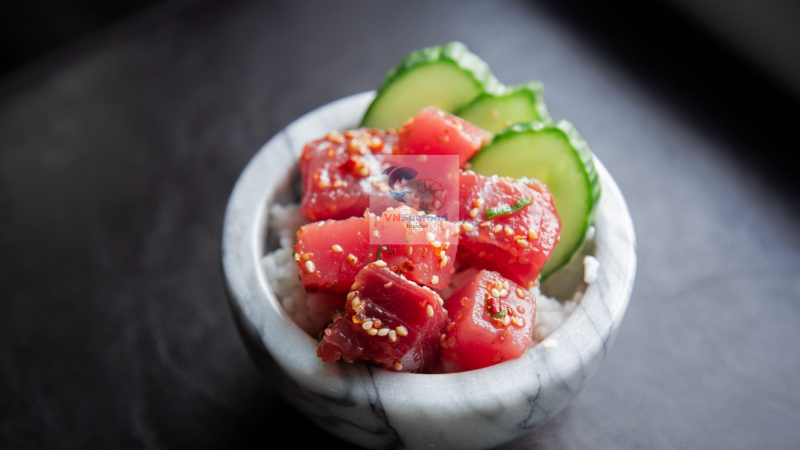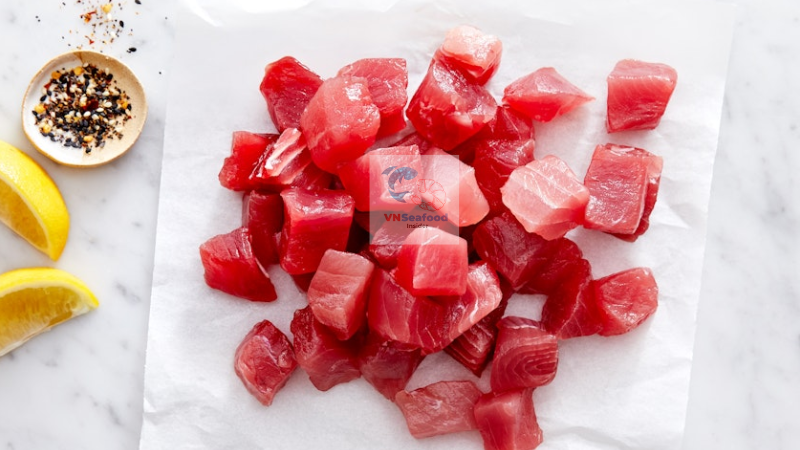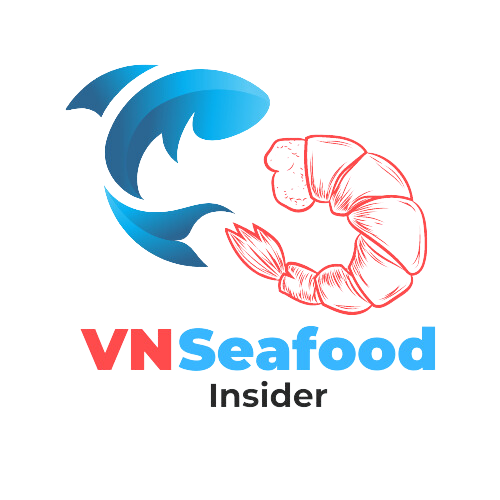As seafood professionals know, not all tuna products are created equal. At VNSeafoodInsider, we’ve seen firsthand how the precision-cut yellowfin tuna cube has revolutionized high-end seafood offerings across global markets. These perfectly portioned cubes of premium tuna meat have become indispensable in professional kitchens and seafood distribution channels alike, offering consistency, versatility, and exceptional quality that discerning customers demand.
Whether you’re a seafood importer looking to diversify your product line, a distributor seeking premium options, or a wholesaler catering to high-end restaurants, understanding the nuances of yellowfin tuna cubes can significantly elevate your seafood business. Let’s dive deep into what makes these culinary gems so special in today’s competitive seafood market.

Outline
ToggleWhat Exactly Are Yellowfin Tuna Cubes?
Yellowfin tuna cubes represent the perfect marriage of traditional seafood craftsmanship and modern culinary convenience. Unlike conventional tuna cuts, these precisely dimensional cubes are meticulously prepared from premium yellowfin tuna (Thunnus albacares), known for its vibrant color, firm texture, and sweet, mild flavor profile that sets it apart from other tuna species.
The transformation from whole yellowfin tuna to perfectly portioned cubes involves skilled processing that maintains the integrity of the meat while creating uniform pieces ideal for consistent cooking and presentation. The resulting product offers chefs and food service professionals ready-to-use tuna portions that require minimal preparation while maximizing yield and reducing waste.
What makes yellowfin tuna cubes particularly valuable in the seafood supply chain is their versatility. These premium cuts can seamlessly transition from high-end sashimi presentations to sophisticated cooked applications, making them a favorite among chefs who demand both quality and flexibility from their seafood ingredients.

Types of Yellowfin Tuna Cube: Understanding the Variety
The world of yellowfin tuna cubes offers remarkable diversity, with different cuts catering to specific culinary applications and customer preferences. As a seafood professional, recognizing these distinctions can help you better serve your clients’ unique needs.
Loin Cubes: The Versatile Workhorses
Harvested from the prized loin section of yellowfin tuna, these cubes feature the firm, meaty texture that many chefs and consumers prize. The density of loin cubes makes them exceptionally versatile – they maintain their integrity during cooking while still offering that characteristic yellowfin tenderness.
For your restaurant clients seeking a multipurpose tuna product, loin cubes are the reliable choice that performs beautifully across different cooking methods – from quick searing to slow poaching. Their robust structure stands up well to marinades without breaking down, making them ideal for menu items requiring longer preparation.
Saku Block Cube: Precision and Presentation
When presentation matters as much as flavor, saku block cubes deliver exceptional results. These uniformly cut rectangular or square pieces originate from carefully selected loin sections, offering consistency that’s crucial for high-end sushi and sashimi presentations.
The meticulous standardization of saku blocks ensures that every piece meets exacting standards for size, color, and texture. For your clients in the premium Japanese restaurant segment, these cubes represent the gold standard, allowing for precise portioning and elegant plating that elevates the dining experience.
Akami (Lean Meat) Cube: The Traditional Choice
For purists seeking the quintessential tuna experience, akami cubes offer the clean, slightly sweet flavor profile and firm texture that showcases yellowfin tuna in its most authentic form. Cut from the leaner, vibrant red sections of the fish, these cubes deliver the classic tuna experience many consumers associate with quality seafood.
The relatively lower fat content of akami cubes makes them particularly appealing to health-conscious consumers while still delivering impressive flavor. For your distribution clients serving traditional sushi establishments or health-focused restaurants, akami cubes provide an excellent balance of tradition and nutritional appeal.
Chutoro and Toro Cube: The Luxury Option
At the premium end of the spectrum, chutoro (medium-fatty) and toro (fatty) cubes represent the height of tuna luxury. These richly marbled cuts are sourced from the fattier sections of yellowfin tuna, offering an indulgent, buttery mouthfeel and complex flavor that creates an unforgettable culinary experience.
While commanding higher prices, these specialty cuts satisfy the growing demand for premium seafood experiences. For your clients serving upscale establishments or specialty markets, chutoro and toro cubes provide an opportunity to differentiate their offerings and capture the high-end segment of the seafood market.
See another post: Vietnam Tuna Export Trends 2025: A Comprehensive Market Insight
Culinary Applications: Beyond Sushi and Sashimi
While yellowfin tuna cubes excel in traditional Japanese preparations, their versatility extends far beyond the sushi counter. Understanding the full spectrum of culinary applications can help you position these premium products effectively in various market segments.

Raw Perfection: Sushi and Sashimi Applications
The pristine quality of yellowfin tuna cubes makes them ideal for raw applications where the natural flavor and texture of the fish take center stage. When supplying to sushi restaurants or poke establishments, emphasize these key points:
- Temperature Control: Highlight your company’s strict cold chain management protocols that maintain the tuna at optimal temperatures (typically -1°C to 1°C) to preserve its sashimi-grade quality.
- Cut Consistency: Stress how the uniform dimensions of tuna cubes allow for consistent portion control and elegant presentation in nigiri, sashimi platters, and poke bowls.
- Flavor Profile: Remind clients that yellowfin tuna offers a more delicate flavor than bluefin, making it accessible to a broader customer base while still delivering premium quality.
Popular raw preparations among restaurant clients include traditional maguro nigiri, spicy tuna tartare, and the ever-growing poke bowl segment that continues to expand across global markets.
Cooked Preparations: Heat-Friendly Applications
Unlike some seafood products that shine only in specific preparations, yellowfin tuna cubes perform exceptionally well across various cooking methods. For clients in more diverse culinary establishments, highlight these versatile applications:
- Searing and Grilling: The firm texture of yellowfin tuna cubes allows for perfect rare to medium-rare searing while maintaining shape and moisture. They’re ideal for composed plates featuring a beautifully caramelized exterior while preserving a rosy center.
- Stir-fries and Sautés: For Asian fusion restaurants, yellowfin tuna cubes can withstand high-heat cooking methods without disintegrating, making them perfect additions to quick stir-fries with bold sauces.
- Sous Vide Applications: The uniform size of tuna cubes ensures consistent cooking results in precisely controlled sous vide preparations, a technique increasingly adopted in high-end restaurants.
- Marinated Specialties: Tuna cubes readily absorb flavors while maintaining their structural integrity, making them excellent candidates for citrus-cured preparations like ceviche or tiradito.
At VNSeafoodInsider, we’ve found that highlighting this versatility helps distributors position yellowfin tuna cubes as premium yet practical options for chefs across different culinary traditions.
Quality Indicators: What Sets Premium Tuna Cubes Apart
In the competitive seafood market, understanding quality indicators helps you select and promote superior yellowfin tuna cube products. Here’s what distinguishes exceptional tuna cubes from average offerings:
Color Consistency: The Visual Appeal
Premium yellowfin tuna cubes exhibit a vibrant, deep red color that speaks to the freshness and proper handling of the fish. This visual characteristic is not merely aesthetic—it indicates that the tuna has been caught, processed, and frozen using methods that preserve its natural qualities.
When sourcing yellowfin tuna cubes, look for consistent coloration throughout the entire batch, without brownish edges or dull patches that might indicate oxidation or temperature abuse during processing.

Texture Profile: The Tactile Experience
Superior yellowfin tuna cubes offer a distinctive firm yet tender texture that maintains its integrity throughout cooking or raw preparation. When thawed properly, premium cubes should feel dense and resilient without being tough, with minimal drip loss that indicates proper processing and freezing techniques.
For your quality control processes, consider implementing a simple texture assessment during product reception, checking that the cubes maintain their shape without excessive moisture release upon gentle pressure.
Clean Processing: The Standard of Excellence
High-quality yellowfin tuna cubes should be free from connective tissue, blood lines, or skin fragments—evidence of careful trimming and attention to detail during processing. This clean presentation not only enhances the visual appeal but also ensures a consistent eating experience without unpleasant textural interruptions.
When evaluating potential suppliers, inquire about their processing standards and quality control measures that ensure only immaculate tuna cubes reach your inventory.
See other post: Top 20 biggest seafood companies in vietnam -> click here
Sourcing and Sustainability: Meeting Market Demands
Today’s seafood buyers increasingly prioritize both quality and sustainability, making responsible sourcing a critical component of successful yellowfin tuna cube marketing.
Fishing Methods and Their Impact
The fishing method used to harvest yellowfin tuna significantly impacts both product quality and environmental footprint:
- Pole-and-Line Caught: This selective fishing method typically produces premium-quality tuna with minimal bycatch, appealing to environmentally conscious buyers seeking responsibly harvested seafood.
- Purse Seine (FAD-Free): Tuna caught using non-FAD purse seine methods offers a balance between volume availability and reduced environmental impact compared to conventional purse seining.
- Longline: While traditional longline fishing has faced sustainability challenges, innovations in circle hook technology and operational practices have improved its environmental profile for some fisheries.
For your marketing materials, clearly communicating the fishing methods used for your yellowfin tuna products helps address the growing consumer demand for transparency in seafood sourcing.
Certifications and Traceability
In today’s marketplace, certifications provide valuable third-party verification of sustainability claims:
- Marine Stewardship Council (MSC): MSC-certified yellowfin tuna cubes appeal to clients with strict sustainability purchasing policies, particularly in Northern European and North American markets.
- Dolphin Safe: This widely recognized certification addresses specific consumer concerns about marine mammal interactions in tuna fisheries.
- Fishery Improvement Projects (FIPs): Products sourced from fisheries engaged in credible FIPs demonstrate a commitment to continuous improvement in sustainability practices.
Beyond certifications, comprehensive traceability from boat to plate has become a fundamental requirement for many institutional buyers and high-end restaurants. Investing in robust traceability systems allows you to provide the documentation increasingly demanded by sophisticated clients.
Storage and Handling: Preserving Premium Quality
Even the highest quality yellowfin tuna cubes can be compromised by improper handling. Providing your clients with clear handling guidelines helps ensure that the exceptional quality of your products reaches the end consumer.

Temperature Management: The Critical Factor
Maintaining optimal temperature is paramount for preserving the quality of yellowfin tuna cubes:
- Frozen Storage: Store frozen tuna cubes at -18°C or below to maintain color, texture, and flavor over extended periods. Fluctuating temperatures are particularly damaging, causing ice crystal formation that disrupts the cellular structure of the fish.
- Thawing Protocol: Recommend gradual thawing under refrigeration (typically 24 hours at 1-3°C) rather than rapid thawing at room temperature or under running water, which can compromise texture and increase drip loss.
- Post-Thaw Handling: Once thawed, yellowfin tuna cubes should be used within 24-48 hours and kept at temperatures between 0-2°C to maintain food safety and optimal quality.
For your distribution clients, consider providing temperature monitoring tools or educational materials that emphasize the critical role of cold chain management in preserving the value of premium tuna products.
Packaging Innovations: Extending Shelf Life
Advances in packaging technology offer significant benefits for yellowfin tuna cube distribution:
- Modified Atmosphere Packaging (MAP): MAP technology can extend the shelf life of fresh (never frozen) tuna cubes by replacing oxygen with a protective gas mixture that inhibits oxidation and microbial growth.
- Vacuum Skin Packaging: This advanced packaging method contours tightly to the product, minimizing air contact while showcasing the visual appeal of premium tuna cubes.
- Portion Control Packaging: Pre-portioned packs of individually quick frozen (IQF) tuna cubes offer convenience for food service operators while minimizing waste and maintaining quality.
By highlighting these packaging options in your product catalog, you can help clients select the format that best meets their operational needs and quality expectations.
Market Trends: Staying Ahead of Consumer Demands
Understanding evolving market trends helps you position yellowfin tuna cubes effectively in a dynamic marketplace:
Health and Nutrition Focus
The exceptional nutritional profile of yellowfin tuna aligns perfectly with contemporary dietary preferences:
- Lean Protein Source: With approximately 25 grams of protein per 100-gram serving and minimal carbohydrates, yellowfin tuna cubes appeal to protein-focused dietary patterns including keto, paleo, and athletic nutrition programs.
- Omega-3 Content: While not as high in omega-3s as fattier fish species, yellowfin tuna still provides these beneficial fatty acids, contributing to heart and brain health.
- Micronutrient Profile: Rich in selenium, vitamin D, and B vitamins, yellowfin tuna offers nutritional benefits beyond its protein content.
For your marketing materials, emphasizing these nutritional attributes helps position yellowfin tuna cubes as premium ingredients for health-conscious consumers and the establishments that serve them.
Culinary Innovation Drivers
Staying attuned to culinary trends allows you to suggest innovative applications for your clients:
- Global Fusion: The adaptability of yellowfin tuna cubes to diverse flavor profiles makes them ideal ingredients for the continuing trend of cross-cultural culinary exploration.
- Minimalist Preparation: The clean flavor and exceptional quality of premium tuna cubes aligns with the trend toward simple preparations that highlight ingredient quality rather than complex techniques.
- Sustainable Luxury: As consumers increasingly seek sustainable options without sacrificing indulgence, responsibly sourced yellowfin tuna cubes offer an appealing combination of environmental consciousness and culinary pleasure.
By sharing trend insights and innovative application ideas with your clients, you position yourself as a valuable partner rather than merely a supplier.
See other post: Top 6 Vietnam Seafood Export Products 2024 – Market Insights and Trends 2025
Conclusion: Elevating Your Seafood Portfolio with Yellowfin Tuna Cubes
Yellowfin tuna cubes represent a premium addition to any seafood import, distribution, or wholesale operation. Their versatility across culinary applications, consistent quality, and alignment with contemporary consumer preferences make them valuable components of a diverse seafood portfolio.
At VNSeafoodInsider, we understand that success in the seafood business requires more than just quality products—it demands comprehensive knowledge of product applications, handling requirements, and market trends. By deepening your understanding of yellowfin tuna cubes and effectively communicating their value to your clients, you can strengthen your position as a trusted seafood provider in an increasingly competitive marketplace.
Whether your clients serve traditional Japanese cuisine, contemporary fusion concepts, or health-focused establishments, yellowfin tuna cubes offer exceptional versatility and premium quality that can elevate their culinary offerings and, by extension, your seafood business.
Have you experienced growing demand for specific types of yellowfin tuna cubes in your market? We’d love to hear about your experiences in the comments below!

Pingback: Tuna Import from Vietnam - Negotiating Price Tatic For Importers